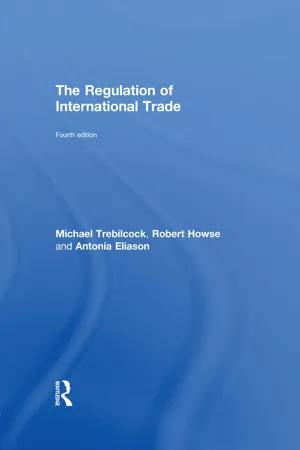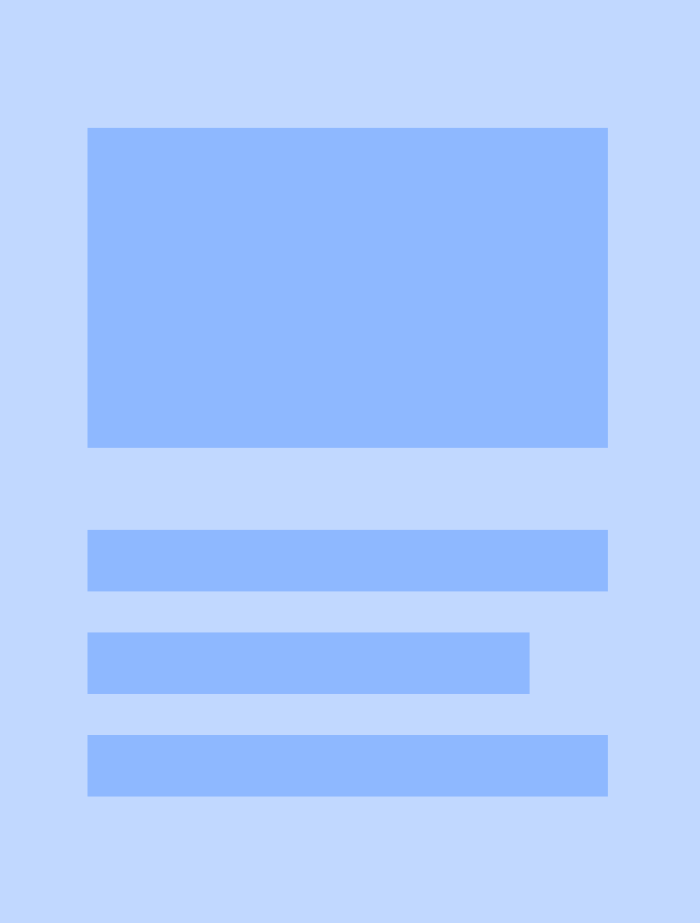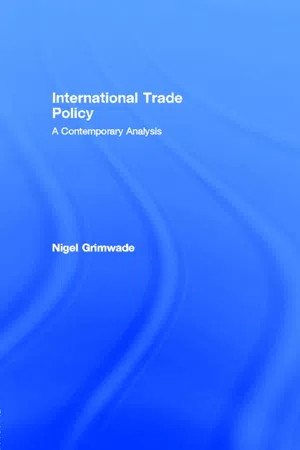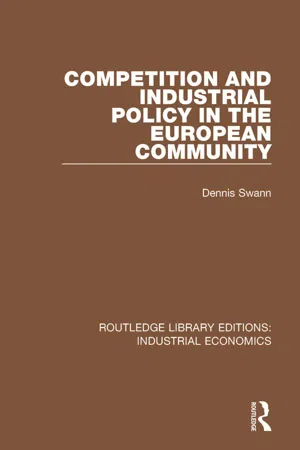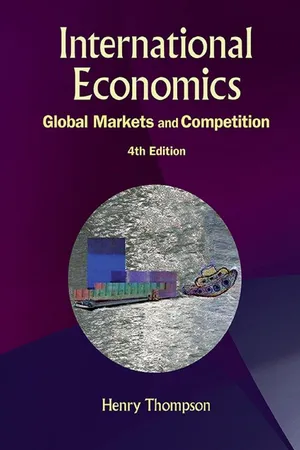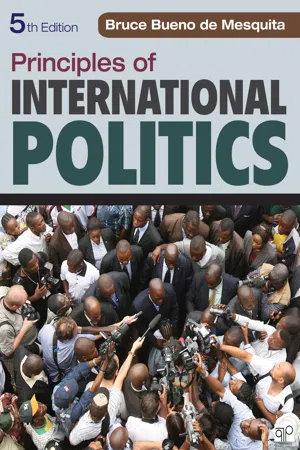Economics
Tariffs and Quotas
Tariffs and quotas are trade barriers used by governments to restrict imports and protect domestic industries. Tariffs are taxes imposed on imported goods, making them more expensive for consumers, while quotas set limits on the quantity of goods that can be imported. Both measures aim to reduce competition from foreign producers and support local businesses.
Written by Perlego with AI-assistance
Related key terms
10 Key excerpts on "Tariffs and Quotas"
- eBook - ePub
The Regulation of International Trade
4th Edition
- Robert Howse, Antonia Eliason(Authors)
- 2013(Publication Date)
- Routledge(Publisher)
For example, governments in importing countries may seek to protect domestic industries by imposing quantitative restrictions (discussed later in this chapter). One means by which a government may impose a quantitative restriction is by creating a quota system. The ‘tariff–quota equivalence’ result indicates that the effects of Tariffs and Quotas on prices in perfectly competitive markets are equivalent. Furthermore, as protectionist devices, quotas have the virtue of definitively limiting the volume of imports and thus they provide a stronger assurance of protection to domestic producers. However, quotas also have the vice, depending on their design, of insulating domestic producers from most forms of foreign competition and thus they may encourage inefficient domestic production. Non-prohibitive tariffs may be surmountable by highly efficient or competitive producers. Under this type of instrument, there may still be some incentive for domestic producers to enhance their productive efficiency. Additionally, when there is only one producer of a product in a domestic market, a non-prohibitive tariff is more effective than a quota at inhibiting this producer’s ability to exercise monopoly power. 6 Another difference between Tariffs and Quotas relates to who collects the scarcity rents that they engender. Governments in importing countries collect revenues from nonprohibitive tariffs, while, depending on how they are allocated, domestic holders of import quotas or licences may collect scarcity rents. If quotas are allocated to foreign exporters, these firms may collect scarcity rents by charging more for their goods in the protected market, without being under any obligation to pay customs duties on the imports. Tariffs should also be distinguished from production subsidies designed to make domestic items artificially competitive with imports - eBook - ePub
- Debraj Ray(Author)
- 1998(Publication Date)
- Princeton University Press(Publisher)
First, there is the question of political power. We already noted that Tariffs and Quotas place revenue in the hands of different groups. Tariff revenues accrue to government, whereas the beneficiaries of a quota reap the implied surplus. Depending on the power of business groups and their lobbies, it is possible to imagine either instrument being used, when, from the allocational point of view discussed earlier, both instruments are equivalent. For instance, if television manufacturers wished to import picture tubes (which are currently banned in an import substitution regime), would they lobby for a quota or its equivalent tariff? The answer is, of course, the quota. It is true that the beneficiaries of the quota would not be able to import beyond the quota (and in this sense the quota is more inflexible), but it is also true that in the presence of the equivalent tariff, they would not have wanted to import more, anyway (consult Figures 17.3 and 17.4 once again). Thus faced with a choice between the two options, television industry lobbyists may prefer the inflexibility of the quota and not have to pay a high tariff on the picture tubes that they do import. A second reason why Tariffs and Quotas may be different stems from the government’s lack of complete information regarding the economy. This requires some explanation. Let’s begin by resurrecting a version of Figure 17.3, which shows the effect of a tariff on imports and domestic production. The main assumption in the illustration that follows is that the government lacks information regarding the domestic supply curve. 8 Suppose that the goal of the government by imposing a tariff is to bring down the import of a good to a preassigned level and at the same time to encourage domestic production. Figure 17.5 essentially reproduces Figure 17.3, but with one important difference: the domestic supply curve is now shown as a band emanating from the free-trade supply point, M - Kenneth Reinert, Ramkishen Rajan, Amy Glass, Lewis Davis(Authors)
- 2010(Publication Date)
- Princeton University Press(Publisher)
The Role of Tariff Quotas in Commercial Policy . New York: Holmes and Meier. An often-cited, early analysis of the practice and theory of TRQs, including its history and treatment under the GATT.Skully, David W. 2001. Economics of Tariff-Rate Quota Administration . U.S. Department of Agriculture, Economic Research Service, Technical Bulletin Number 1893 (April). Washington, DC: USDA. One of the earliest systematic analyses of the economics of alternative TRQ administration methods.World Trade Organization (WTO). 1997. European Communities-Regime for the Importation, Sale, and Distribution of Bananas . Report of the Appellate Body (September 9). WT/DS27/AB/R. Geneva: WTO, Office of the Secretary General. A comprehensive account of the problems associated with the allocation of country specific quotas and import licensing schemes for EU banana imports, providing insightful details for researchers in understanding the variety of practical problems arising from the implementation of TRQs.———. 2006. Tariff Quota Administration Methods and Tariff Quota Fill . Committee on Agriculture Background Paper TN/AG/S/22 (April 27). Geneva: WTO. A comprehensive compilation of quota fill rates by quota administration method and additional regulation for different countries and commodity groups.HARRY DE GORTERtariffs
Tariffs are taxes levied on imported or, less often, exported goods when they cross the border between one customs territory and another. The use of customs duties, a synonym for import tariffs, can be traced back to the Babylonian civilization (18th to 6th centuries BCE). In the 20th century, tariffs fluctuated considerably. Since the end of World War II, however, thanks to eight rounds of tariff negotiations under the General Agreement on Tariffs and Trade (GATT) and to a number of preferential tariff agreements, developed country tariffs have been on a downward trend from an average of 20–30 percent to between 3 and 7 percent. Developing country tariffs have also been substantially reduced, but only since the 1980s. Despite a substantial increase in the number of tariff lines, international comparability and overall transparency in the tariff area increased significantly with the adoption by all countries of a common nomenclature, the so-called Harmonized System (see Hoda 2001).- eBook - ePub
- W. Charles Sawyer, Richard L. Sprinkle(Authors)
- 2020(Publication Date)
- Routledge(Publisher)
While quotas reduce foreign competition in the short run, the long-run anticompetitive effects may be greatly diminished for several reasons. First, quotas may entice foreign firms that are exporting to the domestic market to engage in foreign direct investment in the quota-constrained market. If the domestic market in the importing country is large enough, and the barriers to exporting are sufficiently high, foreign firms may find it profitable to build production facilities in the importing country. This effect is analogous to firms building plants to jump over high tariffs.Second, when an importing country enforces a quota, the quota is stated as a specific number of units without regard to their price. In this case, the exporters have a clear incentive to export the highest quality and the most expensive versions of the product. For example, the U.S. imposed a quota on imports of apparel from Italy in the 1930s. At that time, Italian apparel exports were not the high-quality items we see today. To maximize their revenue from a limited number of exports, Italian firms had a clear incentive to produce higher-quality items for export. Exports of automobiles from Japan are a perfect example of both effects. With the passing of the VER on exports of Japanese cars in the early 1980s, Japanese firms had an even greater incentive to build plants in the U.S. This also gave the Japanese companies a clear incentive to export higher-priced vehicles from Japan. In retrospect, the pressure that U.S. companies placed on government officials to obtain a VER may have been a relatively short-sighted strategy. As a result, a quota or VER can be a two-edged sword. In most cases, a quota will benefit the domestic industry by raising profits in the short run. Whether this will also hold for the long run is another matter.OTHER NONTARIFF DISTORTIONSQuotas are usually considered the most important nontariff barrier to trade. Like tariffs, quotas have effects on international trade that are relatively easy to analyze. However, quotas over time will become less of a barrier to trade, as many quotas are or will be phased out and replaced with tariffs. If Tariffs and Quotas were the only trade restrictions that businesses engaged in international trade had to deal with, conducting international trade would be relatively simple. Businesses would merely need to consider whether a profit could be made given the constraint of a quota and/or a tariff. Unfortunately, governments pursue many other policies that either directly or indirectly affect international trade. These policies may not necessarily prohibit trade, but frequently they distort the amount of trade relative to domestic production. In some cases, the distortion is just a byproduct of a government attempting to accomplish some other objective unrelated to international trade. In other cases, the clear goal is to favor domestic production at the expense of imports. These distortions are becoming increasingly important in the world economy. As explicit trade barriers are reduced worldwide, these other nontariff distortions of trade are becoming relatively more important. - eBook - ePub
- Miltiades Chacholiades(Author)
- 2017(Publication Date)
- Routledge(Publisher)
What follows concerns ad valorem rates only because we will continue to concentrate on relative prices, for which all taxes or subsidies must be expressed in the form of ad valorem rates. Once the equilibrium relative prices are determined, there will be a one-to-one correspondence between the “absolute price level” and the specific rates equivalent to the originally imposed ad valorem rates. Therefore, the effects of the equivalent specific rates will be identical, in long-run equilibrium, to the effects of the ad valorem rates.Quotas, as opposed to taxes and subsidies on imports and exports, control the absolute quantities of exports or imports, as the case may be. A government may wish to limit the imports of a particular commodity to a certain maximum quantity (import quota) per unit of time. For this reason, it may issue import licences that it may either sell to importers at a competitive price or just give away as gifts to importers on a first-come, first-served basis. (Alternatively, the government may consider it desirable to limit the value of imports by providing the importers with a limited amount of foreign currency for the purchase of a particular commodity.) Observe that, while the government can restrict the quantity of a particular commodity imported into the country, it cannot force importers to import a larger quantity than they would have imported under free-trade conditions.A government may consider it desirable to restrict the exports of a particular commodity to a certain maximum quantity (export quota) per unit of time. Thus, exporters may be licensed to sell abroad only a certain quota of the product. Again, while the government is capable of directly reducing exports below their free-trade level, it is impossible to force the exporters through this kind of quantitative restriction to increase their exports beyond the level where they achieve profit maximization.Selected Bibliography
The selected bibliography will be found at end of chapter 20 , p. 444.1 - eBook - ePub
International Trade Policy
A Contemporary Analysis
- Nigel Grimwade(Author)
- 2006(Publication Date)
- Routledge(Publisher)
2 . In the case of a tariff, a rise in demand is met fully by imports and the price does not rise at all.Finally, to a greater extent than tariffs, quotas are discriminatory although they do not have to be. Too often, they are targeted at the world’s lowest-cost suppliers of the product.There would therefore seem to be merit in taking a tougher attitude towards import quotas than towards tariffs. This is indeed the position of the GATT. Article XI opposes all forms of quantitative restriction on trade except in special circumstances. However, the exceptions have been extensively used such that import quotas remain an important barrier to trade. One exception is where quotas are needed to enforce ‘standards or regulations for the classification, grading or marketing of commodities in international trade’ (Article XI, 2: b). Another is agricultural products where restrictions are required in order to restrict domestic supply or to remove a temporary surplus of the domestic product (Article XI, 2: c). Quotas affecting agricultural imports were also subject to the 1955 waiver granted to the United States that arose out of a statute passed by Congress in 1951 mandating quotas on certain agricultural imports. Subsequently, other countries used the US waiver to excuse similar practices. (See Chapter 6 for a fuller discussion of agricultural protectionism.) Not surprisingly, quotas are much more common in agricultural trade.Article XII also permits the use of quotas for the purpose of safeguarding a country’s balance of payments. However, any such restrictions must be progressively relaxed as the country’s balance of payments improves. In other words, they are to be temporary. Interestingly, the GATT rules authorise quotas rather than tariffs where trade restrictions are needed for balance of payments conditions. In practice, countries have generally preferred tariff ‘surcharges’ as a device when faced with such difficulties. Developing countries, which frequently encounter balance of payments problems, have made considerable use of this provision to impose import quotas. Particularly important in this respect is Article XVIII of the GATT under which developing countries have fairly broad freedom to impose quantitative restrictions on imports for general developmental reasons (see Chapter 5 - eBook - ePub
Global Trade Policy
Questions and Answers
- Pamela J. Smith(Author)
- 2013(Publication Date)
- Wiley-Blackwell(Publisher)
Economic Sanctions Reconsidered: History and Current Policy, 2nd edn. Washington, D.C.: Institute for International Economics.Krueger, Anne O. 1974. The political economy of the rent-seeking society. American Economic Review 64 (3): 291–303.McCulloch, Rachel, and Harry G. Johnson. 1973. A note on proportionally distributed quotas. American Economic Review 63 (4): 726–732.de Melo, Jaime, and David Tarr. 1992. A General Equilibrium Analysis of US Foreign Trade Policy. Cambridge, MA: MIT Press.Rom, Michael. 1979. The Role of Tariff Quotas in Commercial Policy. New York: Holmes and Meier.Skully, David W. 2001. Economics of Tariff-Rate Quota Administration. US Department of Agriculture, Economic Research Service, Technical Bulletin Number 1893 (April). Washington, D.C.: USDA.Vousden, N. 1990. The Economic Theory of Protection. Cambridge: Cambridge University Press.World Trade Organization (WTO). 1997. European Communities-Regime for the Importation, Sale, and Distribution of Bananas. Report of the Appellate Body (September 9). Geneva: WTO.World Trade Organization (WTO). 2006. Tariff Quota Administration Methods and Tariff Quota Fill. Committee on Agricuture Background Paper TN/AG/S/22 (April 27). Geneva: WTO.Passage contains an image 8 Policy Comparisons
8.1 What Are Policy Equivalents, and Their Purpose?
This chapter summarizes and compares the effects of the policies discussed in the previous chapters, including tariffs, export subsidies, import quotas, voluntary export restraints (VERs), and bans. To this end, we compare policy equivalents when possible. By this we mean policies that produce quantity, price, and welfare effects that are similar in magnitude.The purpose of comparing policies is to consider their relative effects. Such analysis is insightful in three key ways. First, we can determine who wins and who loses when alternative policies are adopted or liberalized. We will show that certain agents (governments and license holders in particular) are not neutral when it comes to the choice of policy instruments (such as tariffs versus quotas). We will also show that countries are not neutral when it comes to the choice of policies that generate rents (such as quotas versus VERs). Second, we can determine the implications of substituting one policy type for another, such as replacing import quotas with tariffs. This understanding is important in assessing the process of tariffication and in assessing hybrid policy instruments such as tariff rate quotas. Third, we can analyze the effects of alternative policies from a global perspective. That is, we can assess whether some policy instruments are better at raising the aggregate global welfare than others. Insights from these three analyses help explain why different groups within countries and within the global economy tend to support the use of different policy instruments. - Dennis Swann(Author)
- 2018(Publication Date)
- Routledge(Publisher)
2 Tariffs, quotas and equivalent measuresIntroductionThis chapter and the subsequent one are concerned with barriers that impede the process of integration and which have their origin in the activities of the state. Quite clearly such inhibiting factors include tariffs, quotas, and so on, but account must be taken of a variety of non-tariff barriers which also owe their existence to state involvement in the economy – see Chapter 3 . Chapters 4 and 5 will be concerned with other non-tariff barriers which for the most part will be private in origin. In the previous chapter we noted that in varying degrees it was envisaged that economic integration under the Paris and Rome Treaties was to be accomplished through the agency of competitive trade. The growth of interpenetration and interdependence required that the internal barriers should be removed. However since we are concerned with the competition policies of the two Communities it is necessary that we also address ourselves to the question of the degree of external protection. The latter is quite crucial since the degree of competition within the integrated area depends not merely on the ease with which industries and firms in each member state can sell in the markets of other member states but is also governed by the extent to which the integrated market can be penetrated from without. Indeed there are some industries, such as clothing and textiles, where it is quite clear that the main competitive threat is external rather than internal. It would also be quite legitimate to extend our analysis of competition policy to include a discussion of the rules which govern rivalry between Community firms in third country markets. In practice this is not a major concern of either the Paris or the Rome Treaty although some Community policy decisions do relate directly to it and others are indirectly relevant.1- eBook - ePub
International Economics
Global Markets and Competition
- Henry Thompson(Author)
- 2017(Publication Date)
- WSPC(Publisher)
Shrimp is a leading seafood in the US due to efficient farming techniques and global competition. US shrimpers won a dumping case with the ITC in 2004 and were awarded tariffs of 100% on imports. There was no evidence of predatory pricing by exporting Asian countries. The money to pay for the ITC filing came from disaster relief for shrimpers. Congress also awarded the shrimping industry the tariff revenue in violation of WTO rules. The US exports soybeans to Asia for shrimp food, Soybean farmers lobbied to repeal the shrimp tariffs. The only sure winners are lawyers, and government officials receiving lobby payoffs from all sides.CONCLUSION
Protection is the oldest issue in economics and a vital contemporary issue. Protectionism will continue as long as the benefits to protected industries outweigh the costs of lobbying. In a large economy, protection may affect international prices. The next chapter shows how the terms of trade are determined between large economies, and how tariffs may improve the terms of trade.Terms
Antiprotection Production distortion Deadweight loss Protection Dumping Quality upgrading Effective protection Quota license Fair trade Quotas ITC Rent seeking Logrolling Tariffs Nontariff barrier (NTB) Voluntary export restraint (VER) MAIN POINTS
•Tariffs impose deadweight losses that benefit the protected industry at the expense of the economy. •Quotas and other NTBs have become popular due to the mandated lower tariffs in the WTO. •Protection shifts production away from export industries and creates efficiency losses.•Protection occurs when benefits to the protected industry outweigh cost of lobbying. Consumers would benefit from free trade. Antiprotection occurs when industries that export or buy imported intermediate products lobby for free trade.REVIEW PROBLEMS
1.Problems 1 through 9 are based on the domestic demand D = 100 − P and domestic supply of S = −10 + P for sports shoes. Diagram the domestic market. Find imports if the world price is $30.2.Suppose a 50% tariff is put on imports at the international price $30. Find and diagram the change in imports.3.Find the tariff revenue and the deadweight loss with the 50% tariff.4.Find the prohibitive tariff rate .5.With an international price of $30 suppose a quota of 10 is imposed. Find the domestic price with the quota.6.Find the total loss with a quota of 10.7 - eBook - ePub
- Bruce Bueno de Mesquita(Author)
- 2013(Publication Date)
- CQ Press(Publisher)
Tariffs, or fair trade, as such policies are sometimes labeled, are classic private goods subject to many of the political considerations discussed in the context of the selectorate theory. Unregulated trade is a public good that is likewise subject to the political considerations addressed in that same theory. It should be evident that free trade benefits many, whereas fair trade benefits only a few. For the few, of course, the benefit from tariffs may outweigh the value of the public benefit that everyone gets from free trade. Presumably, if no one benefited more from trade protection than from free trade (i.e., if the public-goods benefit outweighed the private-goods component for everyone), then there would be no tariffs or other means of making imports less competitive. In this regard, we should note that tariffs arise for more than one reason. Tariffs can be used to protect domestic industries from competition, as is commonly the case, but they can also be used to punish foreign governments that do not observe free-trade policies in their own right. President George W. Bush justified his call for a tariff on certain steel products in March 2002 by alleging unfair trade practices by Japan and Europe designed to bolster their steel industries at the expense of American industry. They countered—apparently correctly, given how readily the Bush administration negotiated a resolution favorable to Europe’s and Japan’s steel industries—by threatening retaliatory tariffs to compel the United States to enforce its free-trade obligations under the WTO.In all these cases, domestic political considerations seem to be behind the use of tariffs as foreign policy maneuvers. That still leaves us with questions about how tariffs and other trade policies are used by political elites to pick and choose winners and, in doing so, pick and choose how to reward their winning coalition or harm their adversary’s coalition.TRADE AND DOMESTIC WINNERS AND LOSERS
We have seen that free trade, on average, provides cheaper goods and services to consumers. It also provides more abundant goods and services both in quantity and in diversity. Yet free trade has not been the norm throughout history. I have already hinted at why this is so. Free trade is a public good, but the effects of trade involve both public- and private-goods components. Trade affects domestic producers and sellers differently from importers, exporters, and consumers, and government trade policies affect the wealth of each of these groups differently. So the distribution of wealth in a society depends, in part, on governmental approaches to trade. If trade is unrestricted, then domestic producers for the domestic market are at a potential disadvantage, and foreign exporters and domestic importers could have an advantage. Each, depending on how well tied in they are to the leadership’s winning coalition, will lobby more or less effectively for their private, coalition-based gains at the expense of those not in the coalition. In the US setting, for instance, that means that labor union interests will more effectively distort trade policies to protect labor when the Democrats are in office. Large US corporate interests, as reflected by the Chamber of Commerce, the National Association of Manufacturers, and individual corporate lobbyists, will more successfully distort trade policies to protect their interests when the Republicans are in office. In smaller-coalition regimes, the private goods component of trade protection will loom considerably larger than in a large-coalition setting such as in the United States.
Learn about this page
Index pages curate the most relevant extracts from our library of academic textbooks. They’ve been created using an in-house natural language model (NLM), each adding context and meaning to key research topics.
